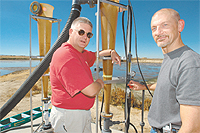forum
library
tutorial
contact

Technology Tackles Phosphorus Problem
by Alice Sherman Hansen, Freelance WriterCapital Press, October 15, 2004
|
the film forum library tutorial contact |

|
Technology Tackles Phosphorus Problemby Alice Sherman Hansen, Freelance WriterCapital Press, October 15, 2004 |
 The cakey white stuff that collects on manure pipes might be dairy farmers’ answer to a nagging nutrient management problem.
The cakey white stuff that collects on manure pipes might be dairy farmers’ answer to a nagging nutrient management problem.
The substance is called struvite. Fertilizer companies used to manufacture the phosphorus-magnesium salt before producing it became too expensive.
Now researchers are testing a new gadget that will help dairy farmers precipitate struvite from dairy wastewater. The cone-shaped device essentially uses a chemical reaction to encourage struvite production.
If it works, farmers may be able to sell struvite as fertilizer and avoid overapplying phosphorus to their land.
“It’s got some real potential,” Joe Harrison, a Washington State University-Buckley extension dairy specialist, said in a telephone interview.
The University of Idaho’s Ron Sheffield has been testing the technology on Southern Idaho dairy farms. Sheffield, an extension waste management engineer, said the crystallizer can remove as much as 60 percent to 85 percent of dissolved phosphorus from dairy wastewater.
The news is promising for Southern Idaho dairies, many of which are facing new mandates to reduce the amount of phosphorus they apply to cropland. Phosphorus overapplication is problematic because it can find its way to waterways through runoff, promoting algal growth. Phosphorus loading has contributed to the problems of Southern Idaho’s Middle Snake River and others on EPA’s list of polluted waterways.
“As the regulatory pressure increases, which it likely will, the scrutiny of phosphorus management is going to be pretty important,” Sheffield said in a telephone interview.
Farmers may consider the device to be another maintenance headache, researchers say. But compared to purchasing land to balance nutrient management, it may be a less expensive way to comply with impending regulations.
Historically, phosphorus has been of less concern to farmers since it appeared to stay in the soil, unlike nitrogen, which can burn plants and leach into groundwater if overapplied.
When farmers adjust for nitrogen when spreading manure, they typically overapply phosphorus. Dairies all “import” it when they purchase feed, but phosphorus doesn’t volatilize like nitrogen.
Only some — maybe 25 percent — leaves the farm in milk. Soil phosphorus then builds up over time.
Though it hasn’t reached the “hot button” stage as dairy odor has, “phosphorus is going to be the next thing that (dairy farmers) have to deal with” in terms of waste management issues, Harrison said.
That’s why Harrison, too, is testing the phosphorus precipitation technology on Western Washington dairies this fall, thanks in part to a grant from the Washington Technology Center. WTC is a state-funded economic development agency that helps entrepreneurs and academic researchers commercialize new technologies.
— and create jobs for small businesses.
For the grant project, Harrison has teamed up with Keith Bowers of Seattle-based startup Multiform Harvest Inc., who developed the technology as a graduate student in the Southeast. He created it for use on southeastern U.S. hog farms.
Bowers said dairy wastewater contains more phosphorus than hog farm wastewater, a benefit for producing struvite.
One-third of Washington state dairies — and many Idaho dairies — use flush systems to clean barns. That water is what’s fed through the cone-shaped crystallizer to produce struvite. The crystallizer is essentially plumbed into the lagoon.
Conditions vary among farms, so the crystallizer is likely to work better on some than others. If it worked well, a farmer may only need to treat wastewater for a short time each year — just enough to meet federal guidelines for phosphorus application.
But Sheffield said it may be more efficient to set up a crystallizer year-round, as part of a manure management system.
A 1 horsepower pump is sufficient to treat 1 million gallons of wastewater per year, Sheffield said.
He’s testing the efficacy of combining the technology with a manure digester to see just how many nutrients can be removed.
Sheffield said the struvite emerging from the crystallizer is akin to wet beach sand — light and easily moved.
“It’s something that’s usable,” Bowers said.
learn more on topics covered in the film
see the video
read the script
learn the songs
discussion forum
